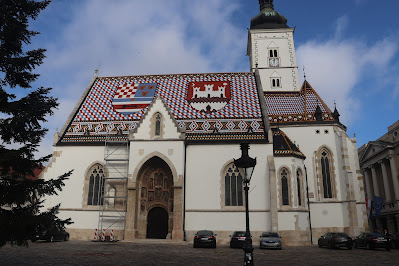 |
| Zagreb Gardens |
Zagreb's
lower town was built during the Austrian Hungarian Empire and resembles a
little Vienna. It also has a green horseshoe series of parks separating the
residential and government buildings from the industrial zone. The University
of Zagreb also has buildings here, but Tito scattered them to discourage
student revolts. We took the funicular (only 200 feet long) to the upper town. The
11th century Kapitol town or Church town was built around the
cathedral. Then the 13th century walls were built around Gradec or
the merchant’s town. A stream flowed between the towns, the two towns fought
each other, destroying mills on each side of the mill until the 17th
century when they united into Zagreb. We saw our first church, St. Catherine’s,
designed by Hermann
Bollé. Then came St. Mark’s
with its tile roof. The three kingdoms are represented here, the checkerboard of
Croatia, three leopards of Dalmatia, and a Martin for Slavonia. Martin skins
were used to pay taxes. Kuna is the word for Martin, which became the name of
Croatia’s currency until the Euro was introduced this year. We passed through
the stone gate, the only remaining gate. Here is worshiped a painting of the
virgin Mary, which survived the fire of May 17, 1731.
 |
| St. Mark |
The Cathedral has been rebuilt several times, the last time after the earthquake in the 18th century by Bollé, but it is built in Limestone and needs constant repair. The earthquake of March 2020 caused the current problem, one spire toppled into the Bishop’s House, the other lies beside the church removed by crane.
 |
| Zagreb Cathedral |
This was a trip just filled with history – the Roman Empire (two larger amphitheaters were a surprise), the Venetian Empire, the Austrian-Hungarian Empire, Napoleon, the Unification of Italy, the creation of Yugoslavia, and its breakup. We were impressed by the location of our hotels and our ship’s berth in the center of towns, making it easy to walk to sights. We enjoyed traveling during the off-season, we were sometimes the only tourists in town. We visited places and did things few Americans experience (truffle hunting, the crafting of gondolas, the vulture center). Unfortunately, Mary tested her theory that she could get along fine on the ship if she wasn’t feeling well. She did spend 4 days in bed, and 8 of 10 days on the ship, but was feeling good enough to do over 24 hours in airports and airplanes when we went home.
A video of this trip is available on youtube.

















































